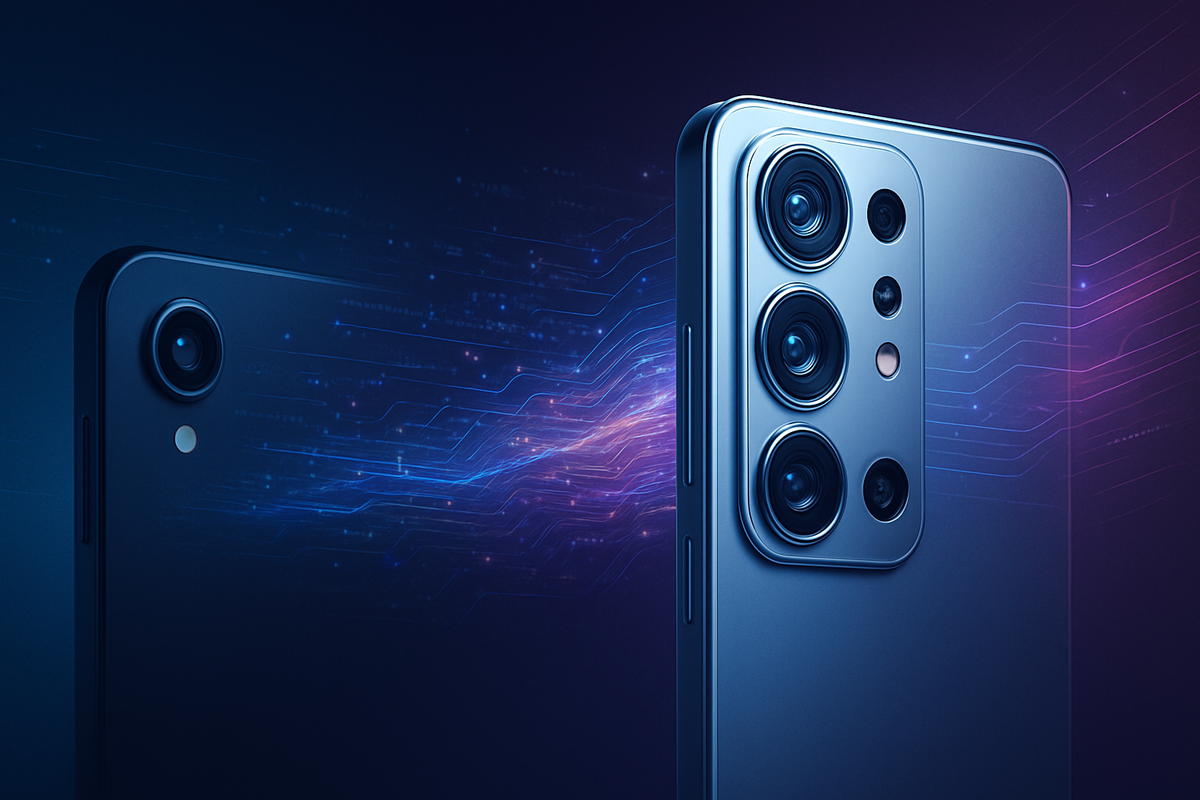
Samsung Electronics Co., Ltd. (KRX: 005930) has been at the forefront of a profound transformation in mobile photography, consistently pushing the boundaries of what a smartphone camera can achieve over the past 15 years. Since the launch of the original Galaxy S in 2010, the company's relentless innovation has evolved smartphone cameras from rudimentary additions into sophisticated imaging powerhouses, fundamentally redefining consumer expectations and setting new industry benchmarks. This journey has not only showcased remarkable technological progress but has also democratized professional-grade photography, making advanced imaging capabilities accessible to the masses.
The immediate implications of Samsung's sustained innovation are far-reaching. It has elevated consumer expectations, making high-quality photography a primary driver in smartphone purchasing decisions. This continuous advancement has spurred an intense competitive environment across the smartphone market, where manufacturers are compelled to invest heavily in camera research and development. Furthermore, Samsung's pioneering spirit in adopting multi-camera systems and integrating artificial intelligence (AI) has shifted the battleground from pure hardware specifications to a sophisticated blend of superior sensors and intelligent software processing, significantly influencing the trajectory of mobile content creation and consumption.
A Decade and a Half of Vision: Samsung's Camera Evolution
Samsung's odyssey in camera innovation began modestly with the Galaxy S in 2010, featuring a single 5-megapixel (MP) rear camera capable of 720p video. This foundational offering quickly paved the way for a rapid succession of advancements that would reshape the mobile photography landscape. The Galaxy S II (2011) boosted resolution to 8MP and introduced 1080p video, while the Galaxy S III (2012) brought innovative features like "Zero Shutter Lag" and "Burst Shot." A significant leap came with the Galaxy S5 (2014), which debuted Phase Detection Autofocus (PDAF) for faster focusing and introduced Samsung's proprietary ISOCELL sensors, designed to improve low-light performance by reducing pixel crosstalk.
The era of advanced imaging and multi-camera systems truly began with the Galaxy S7 (2016), which revolutionized autofocus with the world's first dual-pixel 12MP sensor, a technology previously reserved for DSLRs, dramatically enhancing focus speed and accuracy, especially in low light. This was followed by the Galaxy Note 8 (2017), marking Samsung's entry into dual-camera setups with wide-angle and telephoto lenses, enabling features like Portrait mode (Live Focus). The Galaxy S9 (2018) introduced a groundbreaking "dual aperture" lens, mimicking the human eye by switching between f/1.5 and f/2.4, alongside "Super Slow-mo" video. By the Galaxy S10 (2019), the camera system had expanded to a versatile triple-camera setup, including an ultrawide lens, and introduced "Super Steady" video stabilization.
The turn of the decade ushered in the "megapixel wars" and a strong emphasis on computational photography. The Galaxy S20 Ultra (2020) made headlines with a 108MP main camera and the ambitious "Space Zoom," combining hybrid optical and AI-powered digital zoom for up to 100x magnification, alongside 8K video recording. Subsequent iterations, including the Galaxy S21 Ultra and S22 Ultra, refined the 108MP sensor and integrated dual telephoto lenses, with AI becoming increasingly critical for image processing. The Galaxy S23 Ultra (2023) pushed the envelope further with a 200MP main sensor (ISOCELL HP2), delivering unprecedented detail. Most recently, the Galaxy S24 Ultra and S25 Ultra continued to refine the 200MP sensor, enhancing AI Nightography, introducing pro-level 4K 120fps video, and a suite of Galaxy AI editing features, cementing the smartphone's role as a sophisticated content creation tool.
Market Movers: Winners and Losers in the Camera Arms Race
Samsung's relentless pursuit of camera innovation has inevitably created a dynamic landscape of winners and losers across the financial markets, impacting both direct competitors and the vast supply chain. Companies that have successfully adapted and contributed to this evolution have thrived, while those unable to keep pace have faced significant challenges.
One clear winner is Sony Group Corporation (TYO: 6758), a dominant player in the image sensor market. Samsung's continuous demand for high-quality, high-resolution sensors, even while developing its own ISOCELL technology, has often relied on Sony's expertise, particularly for certain flagship models or specialized components. Sony's advancements in sensor technology, including stacked CMOS sensors and improved low-light performance, have directly benefited from the industry-wide push for better mobile photography driven by Samsung and its rivals. Similarly, companies like Qualcomm Incorporated (NASDAQ: QCOM), which supplies the Snapdragon mobile platforms that power many high-end Android phones, including some Galaxy models, win through the integration of advanced Image Signal Processors (ISPs) and AI engines essential for computational photography. As camera capabilities become more complex, the demand for powerful and efficient processing hardware increases, directly boosting Qualcomm's relevance.
Conversely, direct competitors such as Apple Inc. (NASDAQ: AAPL) and Google LLC (NASDAQ: GOOGL, NASDAQ: GOOG) are in a constant battle to match or surpass Samsung's camera innovations. While these companies have their own strengths – Apple with its consistent image processing and user experience, and Google with its unparalleled computational photography via Pixel phones – Samsung's aggressive hardware advancements force them to accelerate their own research and development. This intense competition means significant R&D expenditures, which can impact profitability if not met with equivalent market share gains. Smaller smartphone manufacturers, particularly those in the mid-range or budget segments, often struggle to integrate the latest camera technologies quickly and affordably, potentially losing market share to dominant players like Samsung that can leverage economies of scale and proprietary technology. Furthermore, the rise of sophisticated smartphone cameras has, to some extent, impacted the dedicated digital camera market, though this effect largely predates the most recent advancements and has been a long-term trend.
Broader Strokes: Industry Trends and Ripple Effects
Samsung's 15 years of Galaxy camera innovation are not merely a tale of individual company success but a microcosm of broader industry trends that have reshaped consumer technology. The most significant trend is the undeniable shift from pure hardware specifications to computational photography and artificial intelligence (AI) as the primary drivers of image quality. Early innovations focused on increasing megapixels or adding optical image stabilization. However, as hardware improvements became incremental, Samsung, alongside other industry leaders, pivoted to leveraging software algorithms and AI to enhance aspects like low-light performance (Night Mode), dynamic range (HDR), video stabilization, and even post-capture editing. This has led to a "software-defined photography" era, where the power of the processor and AI models is as crucial as the sensor itself.
This intense focus on camera technology has created significant ripple effects across the entire mobile ecosystem. Competitors like Apple (NASDAQ: AAPL), Google (NASDAQ: GOOGL, NASDAQ: GOOG), and Chinese manufacturers such as Xiaomi Corporation (HKEX: 1810) and Huawei Technologies Co., Ltd. have been compelled to invest heavily in their own camera R&D, leading to an accelerated pace of innovation across the board. This competitive pressure has benefited consumers, offering an ever-increasing array of sophisticated photographic tools. Furthermore, the rise of "pro-grade" smartphone cameras has fueled the growth of mobile content creation platforms, social media, and professional mobile journalism, democratizing visual storytelling. There are minimal direct regulatory implications, as camera technology is generally self-regulated by market demand and competition, though privacy concerns related to advanced imaging capabilities and facial recognition remain an ongoing societal discussion. Historically, this evolution mirrors the shift from dedicated point-and-shoot cameras to early digital cameras, where convenience and integration eventually superseded specialized functionality for the mass market.
The Road Ahead: Future Possibilities and Challenges
Looking ahead, the trajectory of smartphone camera technology, heavily influenced by Samsung's pioneering efforts, points towards an even deeper integration of computational photography and artificial intelligence. In the short term, we can expect continued refinements in existing areas: enhanced low-light performance, more sophisticated zoom capabilities, and further advancements in video recording, potentially reaching higher frame rates at 8K resolution or introducing new cinematic modes. AI will play an increasingly central role, moving beyond simple image enhancement to more intelligent scene understanding, personalized photography settings, and advanced generative AI for editing and content creation directly on the device.
Longer-term possibilities include the development of truly "invisible" under-display camera technology that doesn't compromise screen integrity or image quality, potentially eliminating notches and punch-holes. There might also be a shift towards micro-lens arrays or liquid lenses for more versatile optical zoom within thinner phone bodies. Samsung's strategic pivots will likely involve not just hardware innovation but also ecosystem integration, leveraging its Galaxy AI platform to offer seamless, AI-powered photo and video editing experiences that differentiate its devices. Market opportunities will emerge for developers creating AI-driven photography apps, specialized accessory manufacturers, and companies providing cloud-based photo and video storage solutions. However, challenges include the increasing cost of integrating cutting-edge camera components, the environmental impact of rapid technological obsolescence, and the ongoing demand for greater battery efficiency to power these advanced features. The potential scenarios include a future where the smartphone completely replaces entry-level dedicated cameras, or one where specialized photographic tools continue to carve out niche markets.
A Legacy of Vision: The Lasting Impact of Galaxy Cameras
Samsung's 15-year journey of Galaxy camera innovation stands as a monumental achievement in consumer electronics, fundamentally reshaping how the world captures and shares visual information. From the early days of basic megapixel counts to the current era of multi-lens systems, computational photography, and artificial intelligence, Samsung (KRX: 005930) has consistently pushed the boundaries, transforming the smartphone from a communication device into a powerful and versatile imaging tool. The key takeaways from this evolution are clear: hardware innovation, while crucial, has been increasingly augmented and amplified by sophisticated software and AI; consumer expectations for mobile photography have been permanently elevated; and the competitive landscape of the smartphone market has been relentlessly driven forward by this camera arms race.
Moving forward, the market will continue to prioritize camera performance as a primary differentiator. Investors should watch for companies that can effectively integrate cutting-edge sensor technology with advanced AI algorithms, as this synergy will define the next generation of mobile photography. Furthermore, the ability to offer unique, AI-powered editing and content creation features will be critical for maintaining market leadership. The lasting impact of Samsung's innovations is evident in every high-quality photo and video captured by a smartphone today, solidifying the device's role as the ubiquitous camera for the modern age and ensuring that mobile photography remains a vibrant and rapidly evolving field for years to come.
This content is intended for informational purposes only and is not financial advice





